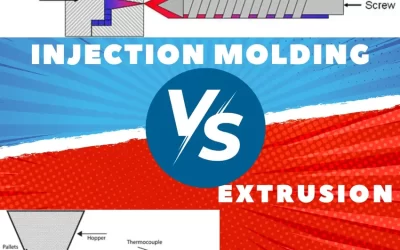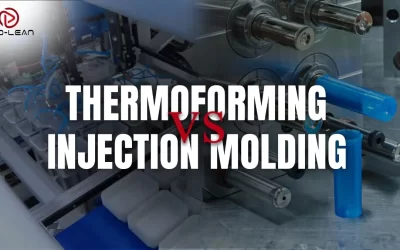“Silicone can be injection molded for several applications. Injection molding to create silicone parts offers precision, flexibility, and efficiency.”
![]()
Several injection molding materials can be shaped into various functional parts and products, silicone is one of them. It is a versatile polymer used in different industries for sealing, gasket, insulation, and other applications. There are many techniques to shape raw silicone into these functional products, and silicone injection molding is one of them. This process involves the injection of liquid silicone rubber into a heated to produce complex shapes with excellent material properties.
This article will discuss valuable insights into the production of silicone parts through the injection molding method, including process, advantages, and applications.
What is Silicone Injection Molding?
It is a remarkable manufacturing process that creates intricate and diverse silicone parts across various industries. This method involves the injection of heated silicone material into a mold, which then cools and solidifies into the desired shape.
![]()
Silicone injection molding
The silicone injection molding machine heats the silicone material to a liquid state. Then, liquid silicone rubber (LSR) is injected under high pressure into a precision-machined mold, typically made from steel or aluminum. The mold is the critical component in defining the final shape and intricacies of the part. Once injected, the silicone is allowed to cool and cure. Next, the part is ejected from the mold with the assistance of ejector pins and goes for post-curing. Finally, the parts are ready for any necessary finishing touches or inspections.
The significance of this process lies not just in its technical capabilities but also in its contribution to advancements in technology and everyday life. It produces high-quality, precise, and complex silicone parts efficiently. Therefore, it holds a significant position in modern manufacturing.
Try Prolean Now!
Silicone Injection Molding Process: Step by Step
If we analyze the injection molding material comparison, It is an intricate process that requires detailed attention at each stage. It can be divided into five key steps, from preparing the silicone material to the actual injection and cooling, and finally, to the ejection and post-processing. Advanced machinery and technical expertise can achieve the complexity and precision of high-quality silicone parts.
Now, let’s elaborate on the five key steps of the silicone injection molding process.
Step 1: Preparing the Silicone Material
First, a base silicone elastomer is mixed with a catalyst, typically a platinum-based compound. The careful preparation of the mixture achieves the desired consistency, ensuring that the final product has the intended physical and chemical properties. Also, color pigments can be added for aesthetic purposes.
The mixture must be homogenous, free from air bubbles, and correctly proportioned. The precision in this phase affects the molding efficiency, flexibility, and aesthetic appeal. Hence, manufacturers often employ advanced mixing and measuring techniques to ensure the material meets stringent standards.
Step 2: Loading the Injection Molding Machine
The molding machine typically consists of a heated barrel equipped with a reciprocating screw. As the silicone material enters the barrel, it’s heated to a predetermined temperature, turning into a viscous liquid state. Here, temperature can range from approximately 250° – 300°.
The precise heating control prevents any degradation of the silicone material. The temperature settings vary depending on the type of silicone used and the desired properties of the final product. The goal is to achieve a smooth, homogeneous melt that can be injected into the mold with consistent pressure, ensuring uniformity and quality in the molded parts.
Step 3: The Molding Process
The actual molding process begins once the silicone material is in its liquid state. The machine injects the silicone into a closed mold at high pressure. This phase is critical for shaping the silicone into the desired form. The mold is usually cooled to accelerate the curing of the silicone, and the high pressure ensures that the material fills every part of the mold, capturing all the fine details.
The intricacies of the mold design play a vital role here. The mold must be precision-engineered to ensure the final product meets the required specifications. This includes the right cavity dimensions, injection molding gate locations, and cooling systems.
Step 4: Cooling and Ejection
After injection of silicone into the mold, it needs time to cool and solidify. The cooling time is essential for the curing process of the silicone, allowing it to take on its final properties and strength. So, the mold design must be able to cool the material evenly, preventing any deformities or inconsistencies.
![]()
Cooling of the silicone part
Once the part has cooled and cured, it is ejected from the mold. The ejection mechanism often includes pins or plates that gently push the part out of the mold. The newly molded silicone part may require additional post-processing steps, such as trimming excess material or further curing.
Step 5: Post-Processing of Molded Parts
The post-processing of the molded parts can include various finishing processes like trimming, where excess material from the molding process, known as flash, is removed.
Other post-processing methods may include additional curing to enhance the physical properties of the silicone, surface treatments for aesthetic or functional purposes, and quality inspections to ensure the part meets all required standards.
Silicone Injection Molding Materials
The diversity of silicone materials offers unique properties based on types and grades. These materials are selected based on specific criteria, aligning with the intended application and performance requirements.
The primary types of silicone used in injection molding include:
- High Consistency Rubber (HCR): Known for its high viscosity, HCR is suitable for high-strength applications like automotive parts and industrial seals.
- Liquid Silicone Rubber (LSR): LSR is favored for its ease of processing, rapid curing, and ability to fill complex molds. It’s used in medical devices, kitchenware, and keypads due to its biocompatibility and heat resistance.
- Fluorosilicone Rubber (FSR): FSR is distinguished by its exceptional chemical resistance, making it suitable for harsh environments, such as automotive fuel systems and aerospace applications.
- Room Temperature Vulcanizing (RTV) Silicones: These are for smaller-scale applications, including prototyping and specialty products, due to their ease of use and curing at room temperature.
What Can be made with Silicone injection Molding?
The injection molding of silicone rubber is a highly versatile manufacturing approach that allows for a vast array of products across multiple industries. The unique properties of silicone, such as its flexibility, heat resistance, chemical stability, and biocompatibility, make it an ideal material for products. Its applications range from medical molding components to automotive parts, consumer goods, and beyond.
![]()
Injection molded silicone parts
The following table illustrates various applications, examples, and reasons why silicone injection molding is the best choice for these applications.
Table: Applications of silicone injection molding
| Medical Devices | Catheters, Implants, Surgical Instruments, and Prosthetic Limbs | Biocompatibility, precision, and durability in sterile conditions |
| Automotive | Gaskets, Seals, Hoses, Engine Mounts, Electrical Insulation | Heat and chemical resistance, durability under stress |
| Consumer Electronics | Protective Cases, Keyboards, Waterproof Seals, Cable Jackets, Earphone Covers | Flexibility, shock absorption, and insulation properties |
| Aerospace and Aviation | Seals, Gaskets, Insulation Panels, Fuel Hoses, O-Rings | Exceptional thermal and chemical stability, and resilience to extreme pressures |
Six Advantages of Using Injection Molding for Silicone Parts
It is renowned for its efficiency, precision, and versatility in producing high-quality silicone components. From medical devices to consumer goods, injection molding facilitates the creation of complex and durable parts, aligning with the demands of various industries.
The following are six key advantages of using injection molding for silicone parts:
1. High Precision and Consistency
One of the most significant advantages is its ability to produce silicone parts with high precision and consistency. The process is exceptionally accurate, allowing manufacturers to produce complex shapes and intricate details with tight tolerance. These precisions are crucial in industries like healthcare and aerospace, where even the slightest deviation can have significant consequences.
2. Compatibility with Complex Designs
Finally, silicone injection molding is compatible with complex designs, allowing for parts with intricate geometries that would be difficult or impossible to achieve with other manufacturing methods. This compatibility opens up various design possibilities, enabling the production of highly specialized and customized silicone parts.
3. Efficiency and Speed
Advanced injection molding machines offer rapid cycle times that enable large-volume production in a relatively short period. This efficiency is beneficial for meeting high-volume demands, reducing overall production time, and overall injection molding cost of silicone parts.
4. Material and Color Flexibility
This injection molding raw material is flexible in terms of materials and color options. Various types of silicone with different properties are available for customization based on the specific requirements of the end product. Additionally, different colors can be achieved by adding pigments with additives.
5. Enhanced Strength and Durability
The process ensures that the material properties, such as tear resistance and tensile strength, are uniformly distributed throughout the part. As a result, molded silicone components become robust and long-lasting, capable of withstanding various environmental stresses.
6. Minimal Waste Production
The silicone molding is highly efficient in terms of material usage. So, it produces minimal waste production. Excess material can often be recycled and reused, contributing to sustainable manufacturing practices. This efficiency reduces material costs and waste disposal expenses.
Try Prolean Now!
Comparison of Silicone Molding Methods
Besides injection molding of silicone, there are other molding methods like compression molding and blow molding.
Injection molding is known for its precision and efficiency, compression molding for its simplicity and cost-effectiveness, and blow molding for creating hollow parts.
Injection vs. Compression Molding
Injection molding machines are highly automated, making them ideal for producing large volumes of intricate parts with consistent quality. It offers high precision, allowing for complex designs with tight tolerances. The process is fast, with short cycle times, making it efficient for mass production.
![]()
Silicone compression molding
In contrast, compression molding involves placing a pre-measured amount of silicone in a heated mold, which is then closed under pressure, allowing the silicone to take the shape of the mold. This method has lower tooling costs than injection molding, making it suitable for smaller production runs and simpler part geometries. The cycle times are typically longer, and the precision and consistency are not as high as in injection molding.
Injection vs. Blow Molding
Injection molding can produce detailed and complex parts with high precision. It’s especially suitable for solid components made from silicone, offering excellent control over the material’s properties and the final product’s dimensions. The process is also adaptable to different silicone grades, enhancing its versatility in various applications. However, it is not suited for creating hollow parts or containers.
![]()
Silicone blow molding
On the other hand, blow molding is suitable for creating hollow objects, such as bottles and containers. This process begins with creating a preform or a parison using injection molding. The parison is then heated and placed in a mold. Air is blown into the parison, expanding it to the shape of the mold, thus creating a hollow part. Blow molding is less precise than injection molding, but it is the best choice for producing large quantities of hollow items. However, precision can be less than injection.
We Mold your Design into Silicone Parts at Prolean
At Prolean, we specialize in bringing designs to life through our precise injection molding service. Our expertise lies in our ability to transform your unique concepts into high-quality, durable silicone parts that meet and exceed industry standards.
We cater to multiple industries, including medical, automotive, aerospace, consumer electronics, etc. Our experienced professionals work closely with each client, ensuring that every aspect of their design is molded into a tangible, functional silicone part.
Our ability to adapt to evolving needs offers flexible and efficient solutions for all their silicone molding needs. Furthermore, we have a seamless, transparent, and collaborative process From the initial design consultation to the final delivery.
Summing Up
This method suits numerous applications, offering precision and design flexibility. It’s efficient, generates minimal waste, and excels in producing a range of products, outperforming other molding methods.
Therefore, silicone injection molding is essential for creating detailed silicone parts in various industries. It heats silicone, transforms it into liquid, injects it into molds, and forms the final shape.
FAQs
Can silicone injection molding be used for complex parts?
Yes, it’s highly suitable for creating intricate parts due to its precision and material flexibility.
What is silicone injection molding?
It’s a process where liquid silicone rubber is heated and injected into molds, forming precise and durable parts.
How does silicone injection molding differ from other molding methods?
It offers greater precision, faster production, and suitability for complex designs.
What types of products can be made with silicone injection molding?
The types of products include medical implants, automotive seals, kitchen utensils, and electronic insulations, among others.
What are the main steps in the silicone injection molding process?
The main steps involve preparing silicone, injecting it into molds, cooling & curing, and followed by ejection and finishing.
Can silicone be injection molded?
Absolutely, silicone is well-suited for injection molding, offering versatility in manufacturing diverse parts.
Resources
Rudolph, N., Pich, F., & Osswald, T. (2011). Effects of temperature and pressure on viscosity during injection molding. Annual Technical Conference – ANTEC, Conference Proceedings, 2, 1540-1545. Retrieved from https://www.researchgate.net/publication/289115688_Effects_of_temperature_and_pressure_on_viscosity_during_injection_molding




I want to add that temperature optimizing is so challenging in silicone injection molding!
Thanks Hannah!
Great! Can you mold us Aerospace O-rings, from mold creation to silicone molding? And how much does it cost?
Yes! We manufacture O-rings and other aerospace parts with plastic injection molding , from mold machining to surface finishing. For the detail budgeting information’s, you can upload your drawing and request a quote.
Simply wanna say that this is extremely helpful in creating my silicone molding DIY project, Thanks for taking your time to write this.
Congrats for your DIY project!